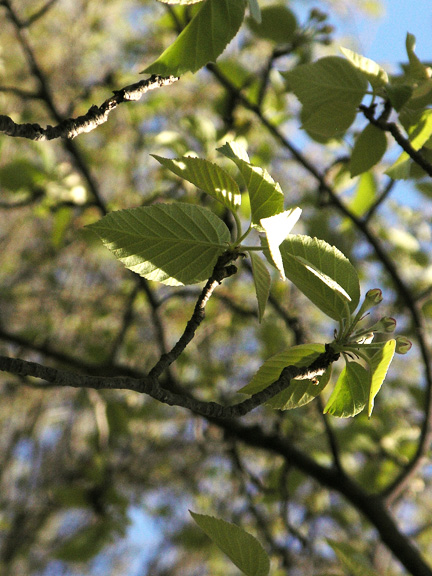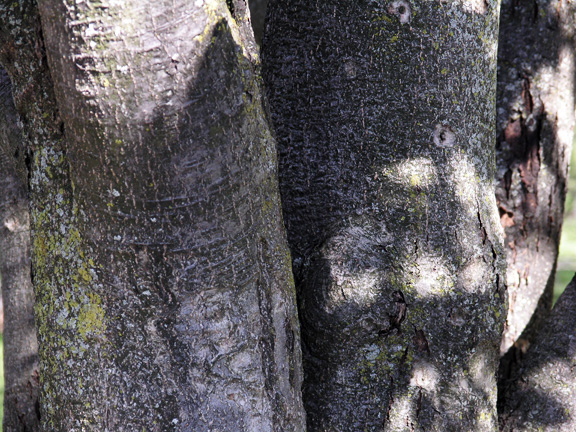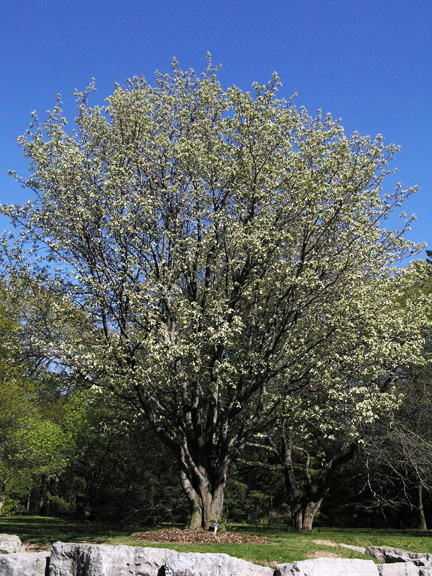
Woody > Malus > Malus tschonoskii > Malus tschonoskii
Malus tschonoskii
Tschonoski Flowering Crabapple, Chonosuki crab, Pillar Crabapple
Origin: Eastern Japan.
Mike's
Opinion


"
A beautiful tree where the flowers are small but still make a statement because of the quantity produced. Spectacular in its autumn cloak of bright orange- red, the colour resembling an apricot or peach. There are a couple of negatives associated with this tree however, one of which is fireblight which can and often does prove fatal. A minor unsightly concern is apple scab which many of the species tend to suffer from.
Michael Pascoe, NDP., ODH., CLT., MSc. (Plant Conservation)
"
| Family |
| Rosaceae |
| Genus |
| Malus |
| Species |
| tschonoskii |
| Category |
| Woody |
| Type |
| Tree (deciduous) |
| Pronunciation |
| USDA Hardiness Zone |
| 4-8 |
| Canadian Hardiness Zone |
| 4-9 |
| Temperature (°C) |
| (-30) |
| Temperature (°F) |
| (-22) |
| Height |
| 5 - 10 m |
| Spread |
| 4 - 6 m |
Photographs
Description and Growing Information
Flowering Period
| General Description |
| A moderately sized crab apple tree, white flowers and yellowish green fruit, medium green leaves. Malus tschonoskii is one of the best specimens for autumn colour. |
| Landscape |
| Suited to park and large landscape plantings, borders and marginal landscape plantings, or to attract wildlife (fruit). |
| Cultivation |
| An easily cultivated plant it performs best in moist but well drained soils that are slightly acidic to slightly basic and does well in heavy clay soils. It is not frost sensitive and even though it fruit set is heavier in full sun it will tolerate partial shade. |
| Shape |
| Compact, to broadly pyramidal tree. |
| Growth |
| Medium |
| ID Characteristic |
| Medium green foliage with slight pinkish white flowers in the spring. Known for its outstanding autumn colour. |
| Pests |
| Insect pests such as aphids, woolly aphid, red spider mite and various leaf chewing caterpillars may be a concern. The tree can experience severe fireblight, apple scab, apple canker and powdery mildew. |
| Habitat |
| Eastern Japan on mountain sides in full sun. |
| Bark/Stem Description |
| Bark is grey – brown, slightly shiny but with a bit of a rough texture. |
| Flower/Leaf Bud Description |
| Buds can be a dark to light pink and are small; 2 - 3 cm in length. |
| Leaf Description |
| Leaves are dense, usually ovate and often lobed. They are a medium green in the spring and summer and turn a deep red or orange in the autumn. Leaves can be up to 12 cm in length. |
| Flower Description |
| Small flowers, 3-5 cm, slightly pink but white when in full bloom. Hermaphrodite, usually 5 petaled, not overly-showy and insect pollinated. |
| Fruit Description |
| The fruit are round to oblong-ovate, 2-3 cm in diameter, changing from yellowish green, lightly dotted to slightly reddish purple with a bit of a gritty texture. The seed as in all malus species contain hydrogen cyanide which in quantity can be toxic. |
| Colour Description |
| The tree has silver looking leaves when young. Turning a medium green through maturity, and is one of the best crab apples for autumn colour, turning brilliant red and orange and sometimes a deep crimson. The bark is a grey-brown while the buds are red to pink: flowers are white flowers. |
| Texture Description |
| Malus tschonoskii is a medium textured tree. |
| Notable Specimens |
| The Arbold Arboretum, Harvard University. Jamacia Plains, Boston Massachusetts. The Royal Botanical Gardens (Arboretum), Burlington, Ontario, Canada. |
| Propagation |
| Malus tschonoskii can be propagated by seed sown in a seedbed or cold frame in autumn when ripe. Stored seed requires stratification for 3 months at 1°C. Seed may not germinate for 12 months or more, seedlings should be transplanted to their own pots and grown on in cold frame for at least another year before being moved. It may also be budded in late summer on common under stock or grafted to such in midwinter. Hardwood cuttings taken in November also show promise. |


